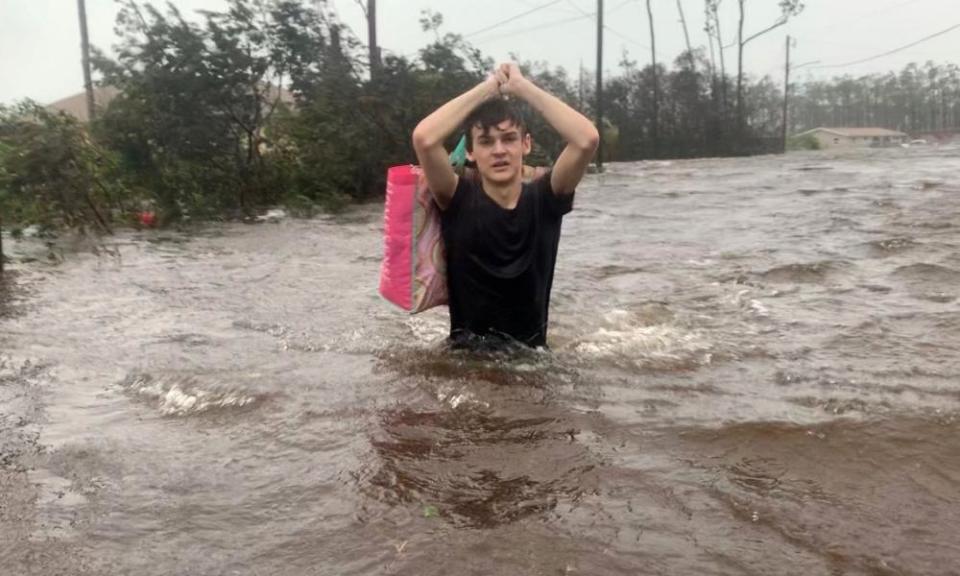Hurricane Dorian edges 'dangerously close' to Florida after battering Bahamas

Hurricane Dorian was edging “dangerously close” to the US mainland on Tuesday, after its catastrophic two-day stall over the Bahamas destroyed thousands of homes and left at least five people dead.
Related: Hurricane Dorian: slow-moving storm batters Bahamas – live updates
Despite weakening to a category 2 storm with sustained winds of 110mph, Dorian remained powerful, experts warned, with the potential to deliver “life-threatening storm surge and dangerous hurricane-force winds” from central Florida to the Carolinas.
The storm’s slow north-westerly crawl towards Florida finally began on Tuesday morning after a relentless 48-hour battering of the Abaco islands and Grand Bahama, causing massive destruction that the Bahamas prime minister, Hubert Minnis, said was an “historic tragedy”.
“The Bahamas is presently at war and being attacked by Hurricane Dorian,” he told the Nassau Guardian. “And yet it has no weapon at its disposal to defend itself during such an assault by this enemy.”
Rescue workers, including some from the US coast guard, worked to lift stranded residents from the roofs of flooded homes. More than 20 people were airlifted to safety in New Providence island, some with serious injuries.
Large areas of Grand Bahama, including the popular tourist resort of Freeport, remained under water.
“The reality of it all is, unfortunately, we will see more deaths. I can’t see any way out of it,” Marvin Dames, the Bahamas minister of national security, told reporters. He added that several of the confirmed dead were children.
Millions in Florida, Georgia and North and South Carolina evacuated inland as Dorian, the most powerful Atlantic hurricane of modern times, began to menace the American mainland.
The National Hurricane Center (NHC) in Miami said in its 11am advisory winds had dropped to almost half the speed of the 200mph gusts that pounded Abaco island at landfall on Sunday.
But the size of the storm was increasing, senior hurricane specialist Dan Brown reported, with hurricane-force winds stretching 60 miles from its core and tropical storm-force winds up to 175mph.
While Dorian’s center is no longer predicted to make a Florida landfall, according to the NHC, the storm is still expected to deliver a powerful blow.
“The increasing size of Dorian’s windfield along with any deviation to the left of the forecast track will bring hurricane-force winds onshore along portions of the Florida east coast,” Brown said.
Dorian’s projected path saw it hugging the Florida coastline for the next 24 to 36 hours, close to the Florida-Georgia border by Wednesday evening and grazing the Carolinas through Thursday and Friday.
The storm has been difficult to predict because of constant atmospheric changes in the Atlantic and Caribbean which left Dorian parked over Grand Bahama for so long.
“Somebody once told me a hurricane is like an elephant on roller-skates,” severe weather expert Jim Lushine, a retired NHC forecaster, told the Florida Sun-Sentinel newspaper. “It doesn’t make a very sharp turn. It has to slow down tremendously before it can turn.”
In Savannah, Georgia, on Tuesday the scene was eerily quiet, 36 hours ahead of the expected arrival of tropical storm force winds. The city, with a group of other Georgian coastal counties, was placed under an evacuation order on Monday by Governor Brian Kemp.

The latest National Weather Service rainfall forecast indicated that the flash flood threat would increase into Wednesday along the Florida peninsula, then spread up the south-eastern and mid-Atlantic coast.
In Miami, which has a large Bahamian community, volunteers and aid agencies were beginning to assemble relief supplies to send to the islands once the storm moved on.
In a tweet using the hashtag #bahamasstrong, Senator Marco Rubio said the government was ready to provide aid and assistance.
As many as 13,000 homes in the Bahamas may have been destroyed or severely damaged, the International Federation of Red Cross and Red Crescent Societies said.
“It looks like they’re boats on top of the water,” said Rosa Knowles-Bain, 61, a resident who fled two days ago to an emergency shelter.
At the White House, staff members reviewed hurricane planning with state and local officials. Donald Trump was being briefed hourly, the White House spokeswoman, Stephanie Grisham, said.
Related: 'It's vicious': terrified Bahamians wait for Hurricane Dorian to pass
After cancelling a visit to Poland to stay in the US and “monitor” the storm, Trump played golf at his course in Virginia on Saturday and Sunday, before receiving hurricane briefings.
Nine counties in Florida issued mandatory evacuations. They included parts of Duval county, home to Jacksonville, one of the two biggest cities in the state, and some areas in Palm Beach county, home to Trump’s Mar-a-Lago resort.
Orlando international airport, one of the largest in Florida, ceased commercial operations at 2am on Tuesday because of the storm, it said in a statement. The airport in Fort Lauderdale planned to resume operations later on Tuesday, officials said.
More than 2,300 flights were cancelled in the US as well as to and from the country. Walt Disney World Resort in Orlando was planning to close at 3pm on Tuesday.
The Associated Press contributed to this report.

